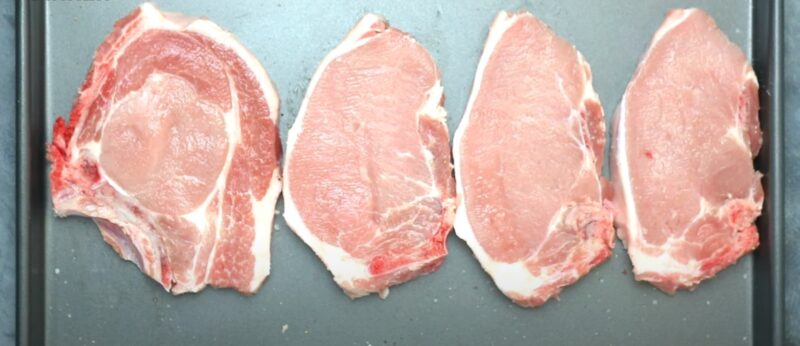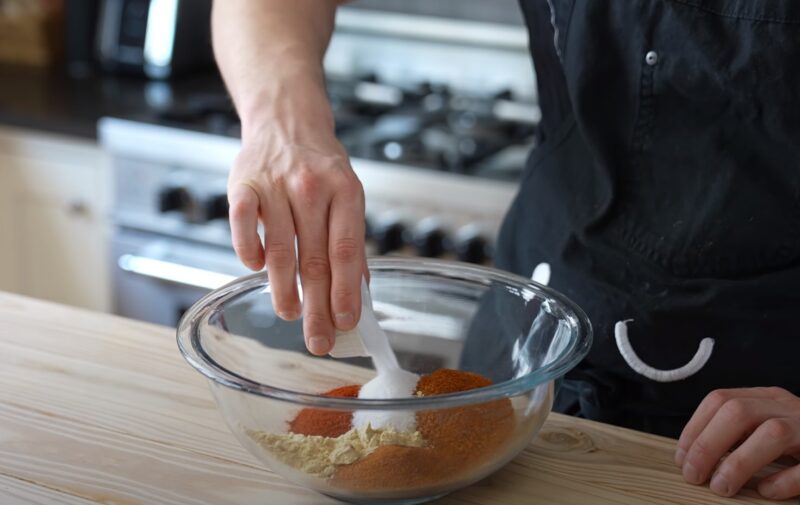Everyone loves pork chops. For me, it is one of the most common things found on the grill.
However, not all recipes are made that way. Many people prefer preparing this type of meat in the oven.
And that’s where I hear a common question – How long to bake it?
Well, first of all, the right temperature is 350 degrees, and now I will write more about the optimal time for a delicious lunch.
Let’s Start With The Basics

If you’re looking to bake some pork chops, just pop them in the oven at 350 degrees.
It’ll take about 20 to 30 minutes, especially if they’re on the thicker side, like 1 to 2 inches.
You don’t need to add extra fat, and they’ll still come out super juicy and tender.
Just make sure to give them a quick check with a thermometer to see if they’ve hit 145 F in the middle.
Once they do, let them rest for 3 minutes, then they’re all set to cut up and enjoy!
Still, keep in mind that this is for a typical cut.
If you have thicker chops, they’ll need a bit more time to cook through. On the flip side, thinner or boneless chops will be ready sooner.
So, the goal is to ensure that the insides are at 145 degrees, making that thermometer quite important, especially if you are a beginner. I know how to recognize the crust to be sure that the meal is done, but you should not rely on that while making the first few pork chops.
But That’s Not the Only Thing Important
You can’t simply put the meat in the oven, and then wait for 20 to 30 minutes. Before that, it requires a little bit of seasoning.
That’s the part where you can adjust the taste according to your preferences.
There are many spices you can combine.
| Salt and Pepper | Classic and simple, enhances natural flavors. | Pan-frying, general seasoning |
| Herbs (Italian seasoning, dill, rosemary, tarragon, sage) | Packs an earthy, flavourful punch. Can be used dried or fresh. | Baking, right before cooking |
| Cajun Seasoning | Blend paprika, garlic powder, onion powder, and black pepper for a spicy kick. | Grilling |
| Celery Salt | Underrated flavor with the right amount of saltiness. | Pan-frying, as a unique seasoning option |
The salt and pepper are something you don’t want to miss. Relax and be generous in treating the raw meat with them.
And for other options, I recommend not to go too far.
My favorite combination is fresh rosemary which I will add during the baking, a few minutes before the meal is done.
Also, you can still add Cajun when baking but don’t add too much. My choice is to add the same amount of salt and pepper. On the other hand, if you are planning to put the chops on a BBQ, don’t think about the amount, just roll the raw meat in this spicy combo.

The next step is to add a side dish. My favorite is potato. But other veggies go just right with pork chops.
However, you can’t just mix them and put them in the oven. The reason is different cooking time.
I would prepare the potatoes, spice them up, and fill the pan with them. Then I will put them in the oven alone, without the meat.
If you are wondering why? Well, they need more time to cook, at least 45 minutes.
So, while they are cooking, I will spice the meat, and brown it a little bit in a fry pan.
And after some 15 to 20 minutes, I will just place the meat over potatoes.
This is for potatoes, while other veggies may need more or less time.
| Asparagus | 8-15 |
| Beets | 24-40 |
| Broccoli | 10-15 |
| Brussels Sprouts (halved) | 20-30 |
| Butternut Squash | 25-40 |
| Carrots | 30-40 |
| Cherry Tomatoes | 25-50 |
| Eggplant | 25-45 |
| Sweet Potatoes | 30-40 |
Final Thoughts
And there you have it. I aimed to make a simple guide to help you make perfect pork chops at home.
The best part is that you can play around with additional ingredients and spices. But still, the key part is to ensure that the meat is well-done. So, be sure to follow a specific guideline, and use the thermometer.
I’m Jamie Omalley. On my blog, you’ll find BBQ recipes and cooking tips to help you make great food at home. Stick around for simple steps and secret ingredients that will help you enjoy grilling delicious food all the time.

